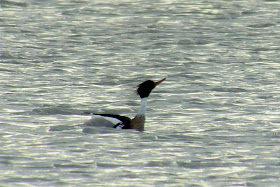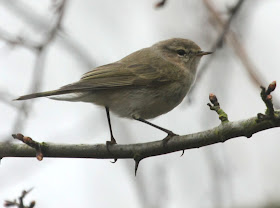Wheatear by Andy Last
Well, March is now over and spring has arrived As is typical for March there's been a mix of lingering winter birds (especially some nice white-winged gulls) and the first spring arrivals, though it seems that some of the spring migrants have been a little late in getting to us. So, what were the highlights of the month?
A Great White Egret flew east over Adderbury on the 16th and this or a second individual was seen in flight following the Thames south at Farmoor on the 19th.
The 2 Short-eared Owls regularly hunting over Moorleys at dusk were joined by a third bird on the 12th. Continuing the raptor fest was the Merlin that was seen sporadically at the RSPB reserve with another individual, a superb record, near Cuddesdon at the start of the month.
Merlin Cuddesdon courtesey of Tom Bedford
Marsh Harrier courtesey of T.S
Otmoor hosted a Harrier double act with the wintering ringtail Hen Harrier-seen throughout March being joined by a Marsh Harrier from the 17th-31st.
First winter Mediterranean Gull courtesey of Nic Hallam
March served up an impressive passage of Med Gulls throughout the county with the lion's share at Farmoor reservoir. At least four birds were present on the 3rd with a pair displaying on the 7th. Away from Farmoor, there were also singles at Port Meadow and Thame on the 4th and at Pit 60 on the 12th.
First winter Caspian Gull Port Meadow courtesey of Adam
Some stunning 1st winter Caspian Gulls were in evidence last month at Port Meadow on the 5th, Farmoor on the 19th a second individual at the res on the 25th and the 27th.
Angelic Iceland Gull courtesey of The Gun-Slinger
At least two Iceland Gulls (a 1st and 2nd winter) were seen regularly over the month ranging between several sites on the Downs including Cholsey, Appleford, Port Meadow and sporadically within the Farmoor roosts.
The adult Little Gull remained at Farmoor throughout March with two of these very attractive small gulls there on the 25th and an impressive 18 birds stopped off at the reservoir on the last day of the month. An adult Kittiwake was intermittent at Farmoor on the 18th-19th and was part of a small influx in to the Midlands.
Red-breasted Merganser courtesey of Dai Johns
Three redhead Smew were still in the south of the county within the Henley Road gravel pit complex on the 16th, and completing the trio of sawbills within the county, was an all too brief appearance of a male Red-breasted Merganser at Farmoor on the 23rd.
Shelduck courtesey of Roger Wyatt
Up to to 30 Shelduck were being recorded at many sites within Oxon over March from the Downs in the south to Wroxton in the north. Five birds found Ashgrave on Otmoor to their liking on the 16th, but it was the flooding on Port Meadow that saw numbers of this attractive duck climbing to an impressive 17 individuals on the 28th even being joined by an escaped Cape Shelduck.
Little-Ringed Plover Port Meadow courtesey of Rog
Little-Ringed Plovers arrived back at Otmoor on the 22nd, Rushy Common on the 23rd and Port Meadow on the 24th. 2 Black-tailed Godwits were on Port Meadow on the 11th with 5 on Otmoor on the 17th rising to 7 birds the next day.
Rock Pipit ssp littoralis Farmoor courtesey of Mark Chivers
A Rock Pipit at Farmoor on the 7th was starting to show its 'true colours' as the moult revealed it belonged to the subspecies littoralis, with two further littoralis Rock Pipits seen on the 12th.
Siberian Chiffchaff Abingdon Sewage Works courtesey of Lew
The Siberian Chiffchaff over-wintering at Abingdon Sewage works was still present until at least the 10th and was occasionally to be heard singing (a rare occurrence in the U.K).
Wheatear courtesey of Mark Chivers
The first Wheatear in the county was at the same site also on the 10th with a notable arrival of this eagerly anticipated harbinger of spring throughout the county from the 20th.
Continuing with the spring migrant theme, a probable White Wagtail (alba) was seen at Grimsbury Reservoir on the 21st with two birds present there on the 22nd. A female alba was also seen near the eastern treatment works at Farmoor on the 29th.
Sand Martins seemed to arrive a little later than usual with the first record at Farmoor the 19th with over 100 birds arriving on the 22nd. The first Swallows also arrived on the 22nd at Farmoor.
The first Reed Warbler announced spring's arrival within Otmoor's waking reedbeds on the very last day of March with the first Willow Warbler in cascading song near Banbury at Grimsbury Reservoir on the 23rd. Other singles starting to trickle through at the tail end of March.
Ring Ouzel courtesey of Mark Merritt
2 Ring Ouzels were discovered on the 23rd both on the Downs near Letcombe Bassett and Sparshold Firs respectively.
Female Bearded Tit Otmoor courtesey of Steve Collier
The lone female Bearded Tit remained throughout the month on Otmoor often offering close views as it ranged widely over the reserve.
A Ring-necked Parakeet was seen near Abingdon on the 17th with three birds seen at the more usual Oxon stronghold of Henley on the 26th.
Lesser-spotted Woodpecker Otmoor courtesey of Steve Lockey
What is arguably one of the most sort after species in Oxfordshire the Lesser-spotted Woodpecker was seen and photographed on Otmoor on the 17th. This diminutive tiny pecker is declining nationally with less than 20 pairs remaining in the county.
Well here it is...the month we have been waiting for...April, when nearly anything can turn up. Looking back through the RBA archives over past Aprils reveals the following tasty morsels: Ring-necked Duck x 3, Common Crane x 6, Golden Oriole, possible Whiskered Tern, Bonaparte's Gull x 2, Hoopoe x 2, Honey Buzzard, White Stork, Dotterel, Black-winged Stilt, Great White Egret, Lapland Bunting, Ring-billed Gull, Furruginous Duck and of course the lingering Oriental Turtle Dove. Plenty there to whet the appetite. Good birding!
Back in Time – Pacific Swift 30th May 1993
by Paul Chandler
I arrived back from Didcot with my daughter as we had just done our monthly shop at Tesco’s on the Sunday morning and just as I pulled up the pager went off with a “mega alert” – Pacific Swift, Cley, Norfolk! I quickly asked my daughter to empty the car and put things away while I rushed upstairs got my birding kit and made a few phone calls. I was also thinking at the time, a 4 hour trip to Norfolk, Swifts don’t normally hang around so will it still be there however if you don’t go for it you won’t see it anyway so the twitch was on. This incidentally was the 2nd record for Britain? And as it turned out the 1st twitchable, the 1st found resting on a North Sea gas platform.
I picked up Geoff and Roger Wyatt and off we “raced” to Norfolk. We hit the road and headed east, as we got on to the M25 we immediately run in to traffic, very frustrating! Crawling along when there was a mega around 100 miles away. After a time we came alongside another birder’s car whilst in the traffic jam and as I remember they were not aware of the “Cley Swift” and we then passed on the info. After a while we were clear of traffic and put on our best speed to Cley and constantly checking the pager for the latest info.
On arriving at Cley the coast road by the marsh was absolutely solid with cars parked on every available verge so we drove along and saw a gap next to a gate, now I don’t normally block gates but this was an exception, so bang, we were in and parked! The others raced from the car and crossed the road while I shut the doors and locked the car. Mark Golley as I recall was at one of the entrances collecting an entrance fee for the twitch and Geoff paid for all of us, so over the bridge and out on the path by the marsh, fortunately the Pacific Swift was still present with a flock of Common Swifts feeding over the marsh. I suppose, fortunately it was a cloudy day with low cloud over the whole area and the swifts stayed in the vicinity feeding. We stood there scanning the flock and occasionally picking out the swift with the white rump but not really getting prolonged views, people were arriving all the time and quite a few still had not seen it, then Geoff locked on to it and called “it's over the brown cow”. That was it I managed then to lock on and so did many others, good call!
We then watched it for around another ten minutes and then a small sun lit gap appeared in the clouds and within a couple of minutes virtually all the swifts had gone including the PS.
Whilst we were all celebrating birders were still arriving but alas the bird was never seen again. As usual after a successful twitch the journey back was less fraught and far more relaxed than the outward journey.

















Cracking write up. Looking forward to April.
ReplyDelete